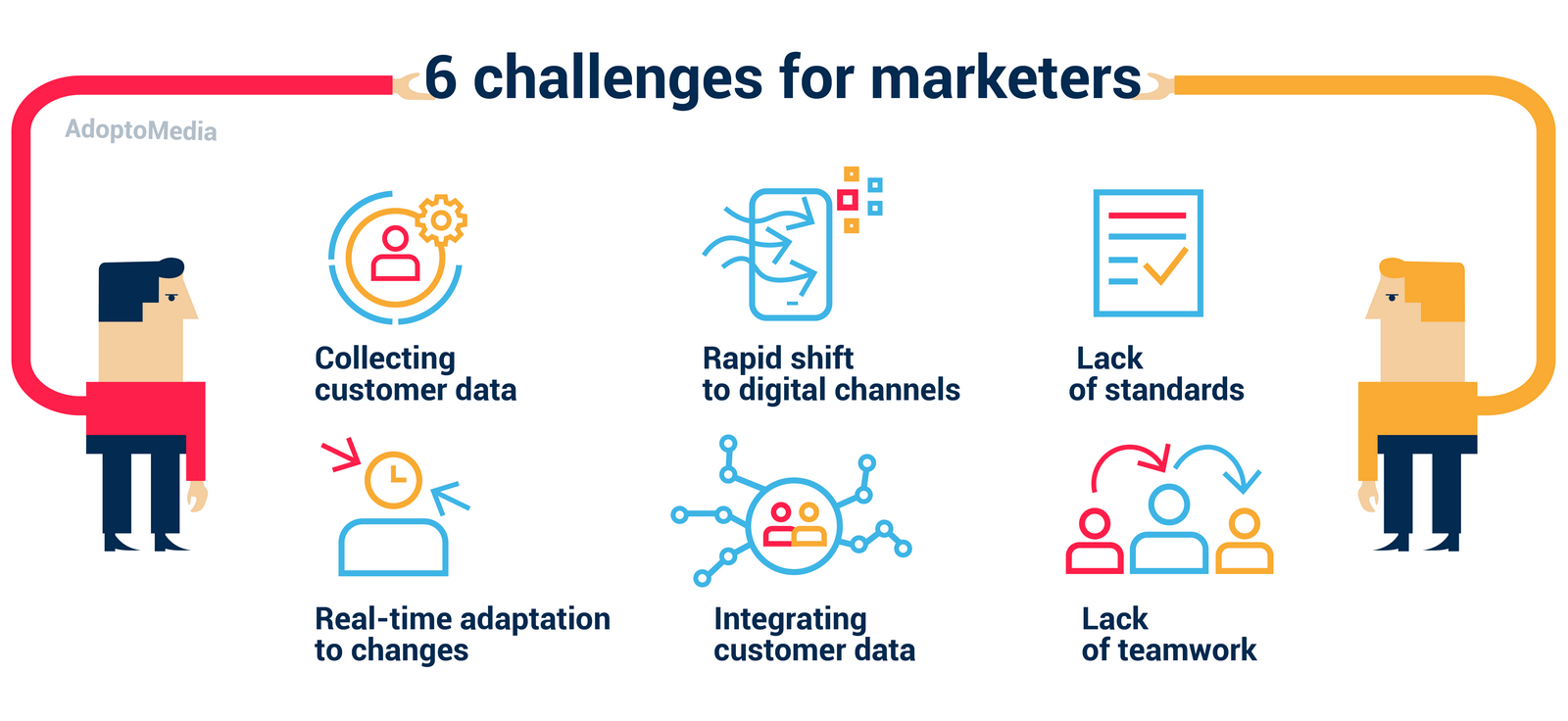
There is no doubt marketing contributes a lot to company’s growth, but how to accurately define its contribution is still to be determined. In this article we cover most common challenges marketers face today and provide some valuable advice from a 2018 research by Forbes on how to apply marketing techniques wisely and quickly implement data-driven insights in your decision-making to increase the enterprise value.
According to the research where over 800 marketing executives were involved, investments in marketing have become the major contributor to company value in today’s digitally driven economy. Market conditions are changing quickly, intangible assets like brand equity, innovations and customer relationships are becoming increasingly important. To monitor complex, fast changing customer journey and address numerous other problems marketers worldwide annually spend about $1 trillion, moreover they are struggling to justify these huge expenses as well as measure their effectiveness. Most CMOs use over twenty tools; with this variety it’s getting more difficult to measure and optimize marketing investments. The need for higher marketing accountability shows that an international measurement standards should be established. Here are three reasons why organizations need to better understand, measure and improve marketing?
-
Investors and owners need to see the impact of innovation on company value, which is significant in the economy of intangible assets and digital technology.
-
CMOs need facts to explain their investment decisions. If there is no universal standards for measuring marketing effectiveness, companies will have trouble making critical decisions about budget reallocations. You will be surprised that many executives still base them only on experience without turning to data facts about customers. Also, existing analytics is better for tactical rather than strategic decisions, which is a major drawback.
-
Brands need to find what customers want to meet their expectations. Growth now mostly comes from digital channels, so companies need to make people’s online experience with the brand as smooth as possible, because customers influence market a lot.
Even though marketers understand the importance of measuring and improving effectiveness of their actions, it is easier said than done, because ROI has always been difficult to measure accurately, moreover the digitalization is taking over very quickly and the technology is struggling to keep pace with all the emerging needs. Analytics, which accounts for at least 5% of marketing budgets in leading companies, helps to make more informed decisions and measure the effectiveness, but still there is not enough accountability and transparency in the industry.

Here are six most common challenges marketers face today:
-
Collecting customer data from too many touch points. To tackle this problem leading marketers create data maps to integrate information.
-
Customers are massively shifting to digital and mobile channels, so it’s necessary to make right decisions about reallocation of investments. It’s always risky to try something new when there is not enough data, but if you wait too long, the chance will be taken by your competitors.
-
The need to adapt to changing customer preferences in real time pushes marketers to focus more on enhancing customer experience.
-
Building an integrated customer portfolio to cover all customer experience with data coming from a growing number of touch points, marketing technology platforms, etc. According to Gartner, MarTech accounts for 27% of CMOs budget.
-
The lack of collaboration between departments (Marketing, Finance, IT, etc.) makes it more difficult to get a comprehensive view of the customer, while effective teamwork can ensure a best-in-class customer experience. However, it’s easier said than done becasue there are four reasons that prevent Marketing and Finance from achieving effective cooperation.
-
Lack of international standards for measuring marketing performance complicates the decision-making process, however thanks to recent technological advances the dynamic is changing. Anyway, it’s more difficult to measure marketing effectiveness than physical assets or product quality.
Ironically, marketing is the key growth driver, but its performance is most difficult to measure.
In the research Forbes experts identify 18 ways in which marketing investments, strategies and assets can contribute to the enterprise value and stimulate growth. They also give advice to marketers on implementing customer data in real time to achieve best-in-class performance and efficiency. Today intangible assets like innovation or customer experience are becoming increasingly important. Customer equity is also a significant contributor; companies like LinkedIn, Airbnb have valuable assets in the form of customer networks. Customers’ high engagement and satisfaction levels provide long-term benefits like sales increase. Forbes research shows that right marketing actions can contribute to brand value, online performance, customer relationships and innovation, all of which drive share prices. With the following information you can structure your marketing, measure its contribution to brand value and find ways to maximize it. Let’s look at each aspect in detail.
Brand value refers to the perception of a brand’s overall worth in the eyes of the consumer, often reflected in how much customers are willing to pay for its products. To maintain it, marketers should focus on two key metrics: brand awareness and trust. This data can be obtained through different customer surveys, ratings, digital channels, questionnaires. Brand studies is actually one of four tools that can be effectively used for cross-media measurements. By monitoring these metrics you can check the brand strength as well as forecast market trends and changes of customer attitude that can significantly affect your company. It contributes to overall enterprise value in the following ways:
-
Brand assets — even though not tangible, are worth about 20% of total enterprise value, but many companies don’t measure it. According to Forbes, the top 100 global brands have a total worth of $2 trillion.
-
Brand preference affects market share, changes customers’ behavior and secures future sales even if your price is higher than competitor’s. CMOs should focus on share of voice as well as voice of the customer benchmarks, which help to understand the brand value compared to competitors and make long-term strategic investment decisions.
-
Brand momentum shows how effective and efficient brand’s actions are. Marketers should check customers’ sentiment towards competing brands and trends in sentiment. These metrics reflect customers’ reactions, indicate market trends, brand health, and help executives to optimize strategy, positioning, etc.
Next aspect is customer equity, which can also guarantee sales growth and contribute significantly to enterprise value in the following ways:
-
Customer satisfaction level is a highly strategic aspect. If you want to secure growth, value increase and future sales, make sure your customers are satisfied by experience with your brand. Do that, and they will choose you even if the competitor’s quality is the same. Satisfied customers spread word of mouth, which remains the most effective and trusted advertising despite all the technological advancements. Use surveys and ratings to track customers’ response to service events as well as their sentiments about the services across various touch points to understand if people are willing to buy your product and make timely changes to tactical and strategic actions.
-
Customer loyalty reflects how good the company is at retaining customers. Loyal customers are also very likely to recommend you to others and spend more, especially when it comes to companies with software products or subscriptions. To learn more about this factor you should track referrals, recommendations that prompted a purchase, measure customers interaction with your brand along the journey. This data can be obtained by analyzing customer conversations, various digital touchpoints, surveys, NPS (Net Promoter Score). With this information executives can make tactical changes and improve customer service.
-
Customer relationship, which can be defined as quality and frequency of engagement with customers, is becoming increasingly important. Over the last 40 years marketing shifted its focus from product to customer, which led to emphasis on long-term relationship with customers. To evaluate this aspect marketers should know how many customers are actively engaged with the brand in different channels and how often it happens. These metrics show the state of overall health of relationship with customer.
Organizational competence is also proven to have direct impact on enterprise value. The key message here is that it’s important to collaborate and invest in data-driven technology to grow.
-
Organizational knowledge sharing is crucial for achieving high level marketing accountability. With special systems companies are guaranteed to perform better as well as more effectively generate, share and respond to new information. Such systems take time and resources to implement, but they always pay off. The faster and more effectively you can use the information, the better results you get.
-
Interdepartmental connectedness is necessary to solve arising challenges faster and more effectively, so all company units should cooperate moving towards one common goal. Even though it’s not easy to do at once, the result is worth the efforts, because by joining capabilities companies can explore hybrid sales or successfully launch DTC (direct to consumer) channels, which will eventually drive enterprise value. Another benefit of interdepartmental cooperation is simplified operations and increased transparency.
-
Organizational measurement capability is key to development and growth. Only with good tools for measuring marketing performance can a company identify its strong and weak points, build effective strategies, forecast outcomes and maximize the impact of every dollar spent on marketing. Highly accountable companies, that base decisions about measurements and optimization on data-driven insights, have stronger ROMI. An example of a smart tool that can increase company’s measurement capabilities is a solution by AdoptoMedia, which relies on Marketing Mix Modeling to automatically measure and optimize marketing investments by channel or region.
-
Marketing effectiveness contributes a lot to company’s growth and overall business strategy. In a previous article the term “business effectiveness” is even used instead to emphasize the potential and importance of marketing.
-
Sales and service effectiveness can definitely drive value directly by generating more income with less expenses. Here marketing should collaborate with sales to find and effectively engage growth points. For example, price premiums combined with right marketing investments will result in a stable organic growth.
-
Channel reach, share and performance also contribute to value in the environment where customers’ behavior changes quickly. Digital platforms and DTC channels are a great new asset that drives growth and value, which has been proven by Walmart’s and other companies’ experience.
-
Owned Digital Marketing Performance shows how effective your own online channels (websites, blogs, etc.) are. Many CMOs are heavily investing into this asset to increase ad reach and site traffic with less resources and lower future cost of sales. If a company wants to stay successful or even survive, it needs to cover numerous channels and consider digital transformation in the nearest future. To understand how well owned digital platforms are managed, marketers should monitor customer engagement (number of visits, their duration, conversions) and evaluate content effectiveness.
-
Digital channel performance is an important aspect because as of 2018 about 15% of sales were made online, and this figure will grow. Here again you need to measure customer engagement level and quality as well as monitor ratings at the moment of purchase. All this data can be collected on e-commerce platforms and used to optimize targeting, promotion, etc.
-
Digital experience is more important for customers than price, so companies are trying to make digital experience more satisfactory with advances in MarTech. Many marketers put customer experience in the centre of their decision-making process. By monitoring customers reactions and transition between the channel touch points through ratings, surveys, content consumption, conversion rates marketers can enhance and prevent possible problems with digital experience.
The last aspect that drives firm value is quality of products and employees.
-
Employee Talent and Leadership are other crucial drivers. If a company manages to hire and retain talented employees, unite them for an effective work towards a common goal and build strong leadership, it will have a high value. Since employee advocacy strengthens brand and creates a positive image, marketers should measure the strength of employee advocacy and check if they can provide the best customer experience. With this information necessary training can be organized to improve the brand perception by customers.
-
Perceptions of Firm Innovation — if customers see that you implement innovations, they think you are better equipped to solve their problems. Investments in innovation pay off really well, they also makeup about 10% of CMOs budgets. By identifying which customer needs aren’t being met, you gain insights that can guide future tactical and strategic decisions.
-
Product and service quality obviously have a great impact on customers, sales and value. Investments in quality are long-term and will pay off over 6 years, according to a Marketing Science Institute study.
Thanks to technological advancements, there are tools that help companies address the challenges mentioned earlier. One such tool is proprietary technology from AdoptoMedia, which can analyze the contribution of both online and offline channels to sales or other KPIs. Our platform evaluates the effectiveness of the media mix and budget allocation, runs “what-if” scenarios, and provides optimization recommendations that help increase ROMI by 15-30%. With our solution, you can reduce media spend without affecting sales or achieve maximum KPI levels within a given budget. This software is smoothly integrated into the company’s IT infrastructure, making digital transformation simple. Try AdoptoMedia to achieve best-in-class marketing accountability and transparency, optimize expenses, boost marketing performance generate actionable tactical decisions based on data-driven insights in addition to building an effective strategy.


